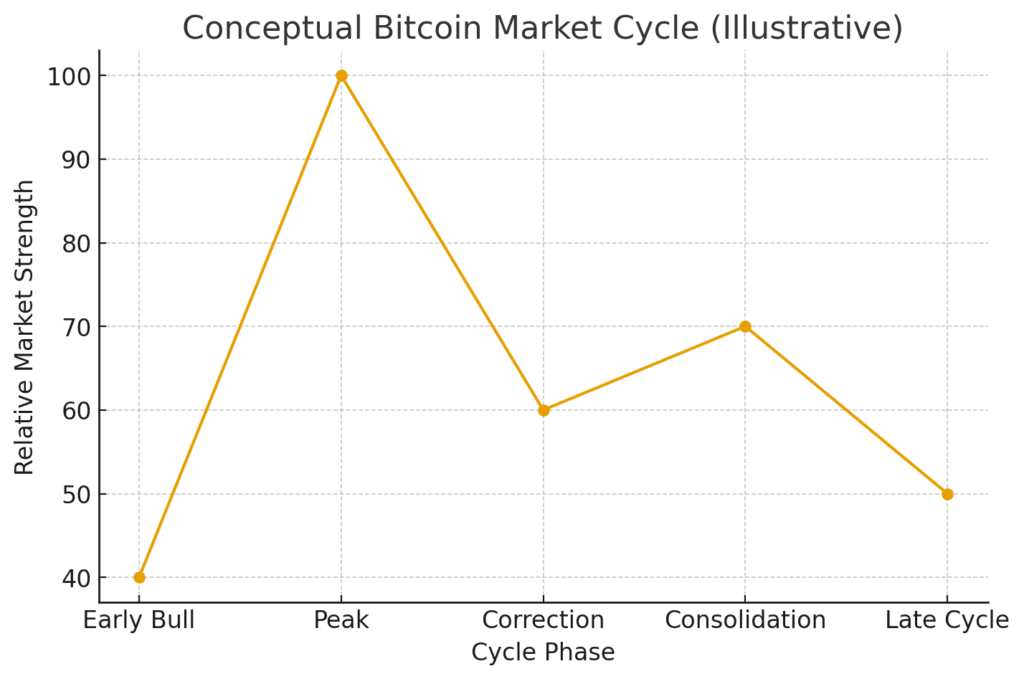
Main Points :
- Bitcoin has reached its “most bearish” level in the current 2023–2025 bull cycle, according to CryptoQuant’s on-chain metrics.
- Institutional demand—previously the core driver of Bitcoin’s surge—is weakening sharply, with ETF inflows slowing by nearly 30% compared to the previous year.
- Corporate Bitcoin buyers such as MicroStrategy and Metaplanet have reduced or paused accumulation.
- BTC has fallen below the critical 365-day moving average (approximately $102,000), now acting as strong resistance.
- Despite bearish conditions, historical cycles show that late-cycle recoveries of 40–50% can still occur.
- Bitcoin is currently sitting near major support in the $90,000–$92,000 range, after briefly dipping to $88,400.
- Analysts warn that no strong catalysts are visible for 2026 unless unexpected macro or geopolitical events emerge.
Bitcoin Enters Its Most Bearish Phase of the Cycle
1. Current Market Overview: A Deep Shift From Euphoria to Exhaustion
CryptoQuant’s latest weekly report shows that Bitcoin has entered the weakest point of its current bull cycle, which began in January 2023. Their proprietary Bull Score Index—a metric measuring institutional demand, market momentum, and on-chain expansion—has dropped to 20/100, marking extremely bearish territory.
Bitcoin has also lost its grip on the 365-day moving average (≈ $102,000), a historically important indicator. Falling below this line has triggered major downtrends in past cycles, including the 2022 bear market.
Meanwhile, Bitcoin is trading near $91,650, only slightly above this week’s low of $88,400, which is the lowest level since April 2025.
Institutional Demand Is Weakening Sharply
2. Corporate Bitcoin Purchases No Longer Provide Price Support
Institutional activity—which propelled Bitcoin to its first-ever $100,000+ price in late 2024—has slowed dramatically.
MicroStrategy recently purchased 8,178 BTC worth $835 million, its largest acquisition since July 2025.
But CryptoQuant’s head of research Julio Moreno noted that:
“Corporate buyers have essentially stopped buying, and some have started selling.”
He also referenced Metaplanet, which has not made a major purchase since September.
ETF inflows tell a similar story:
- 2025 ETF inflows YTD: $27.4 billion
- 2024 ETF inflows YTD: $41.7 billion
This represents a ~30% decline, showing that new capital entering the market is slowing.
Major Market Drivers Have Disappeared
3. The Catalysts Behind the 2024–2025 Bull Run Are Gone
CryptoQuant highlighted two previous key drivers:
- Trump’s 2024 election victory, which triggered Bitcoin’s breakout above $100,000.
- New Bitcoin-focused corporate financial firms launching in 2025, which pushed BTC above $120,000 in August.
However, the report concludes:
“These catalysts have faded. It is unclear what could meaningfully accelerate Bitcoin demand in 2026.”
Potential large-scale catalysts—such as a hypothetical US Strategic Bitcoin Reserve—are considered unlikely. Meanwhile, continued Fed rate cuts appear to be fully priced in by the market.
Where Are We in the Bitcoin Four-Year Cycle?
4. Bitcoin Appears to Be in the Final Phase of the 2022–2025 Cycle
CryptoQuant notes that Bitcoin’s current decline is consistent with two previous four-year cycles:
- 2014–2017
- 2018–2021
If this pattern holds, the 2022–2025 cycle is entering its final stage.
Despite this, the report emphasizes:
“This does not mean Bitcoin will collapse. The current 28% drawdown places BTC directly on major support at $90,000–$92,000.”
Historically, even late-cycle bear phases include:
- 40–50% relief rallies
- multi-month consolidations
- attempts to retest the 365-day MA
With the 365-day MA now around $102,600, it has become formidable resistance.Illustrative Bitcoin Cycle Chart

5. Market Sentiment: Late-Cycle Fatigue and Uncertainty
Sentiment across crypto derivatives, funding rates, and volatility suggests a market caught between caution and hope:
- Funding rates have normalized from previously overheated levels.
- Open interest dropped sharply after Bitcoin’s fall below $95,000.
- Volatility indices have risen but remain below “capitulation” levels.
Traders are positioning for a slow grind, not a catastrophic breakdown.
6. Broader Industry Trends to Watch (2025–2026)
To enrich the analysis beyond the source article, here are additional trends shaping Bitcoin’s mid-term outlook:
a. Institutional Rotation Into Tokenized Real-World Assets (RWA)
BlackRock, Franklin Templeton, and Fidelity are increasingly prioritizing RWA tokenization. This may reduce capital inflows into Bitcoin ETFs.
b. Expanding Regulatory Pressure
- Europe’s MiCA Phase 2 takes effect in 2026.
- The US is moving toward clearer digital asset legislation after the 2026 elections.
- Asia (Japan, Singapore, Philippines) is tightening VASP oversight.
These shifts affect institutional willingness to take long-term BTC exposure.
c. Lightning Network Plateau
Lightning growth slowed in 2024–2025 as competing L2 solutions (Stacks, BitVM-based rollups) gained attention.
Slower innovation may reduce BTC’s utility narrative.
d. Corporate Treasury Adoption Stabilizing
Most corporations that wanted BTC exposure have already entered.
New entrants are fewer compared to 2021–2024.
7. Outlook: What Could Reignite the Next Bull Run?
Although no major catalyst is visible now, several possibilities remain:
• US Federal Reserve Unexpected Policy Shift
A faster-than-expected return to quantitative easing (QE) could spark renewed risk appetite.
• Large-Scale Corporate Bitcoin Adoption 2.0
If Fortune 500 companies integrate Bitcoin payments or long-term treasury allocation, demand could return.
• Breakthrough in Bitcoin Layer-2 ecosystems
If BitVM rollups or sovereign BTC subnets achieve scalability, Bitcoin could gain new utility.
• Geopolitical Stress or Capital Flight
Historically, Bitcoin rallies when traditional financial confidence deteriorates.
Conclusion: A Bearish Phase, but Not the End of the Cycle
Bitcoin is clearly in a late-cycle correction phase.
Institutional flows, ETF demand, and corporate buyers have weakened significantly.
Yet, Bitcoin remains within its historical framework:
- Support at $90,000–$92,000
- Potential for 40–50% relief rallies
- Strong resistance at the 365-day MA (~$102,600)
The bull cycle may not be “over,” but it has certainly entered a mature and uncertain stage, where opportunities exist—but require caution, deeper research, and selective positioning.
For investors searching for new crypto assets, yield opportunities, and practical blockchain applications, this environment favors:
- undervalued altcoins with real utility,
- tokens benefiting from RWA adoption,
- BTC layer-2 innovation projects,
- enterprise-grade blockchain infrastructure plays.
The market has shifted—but not ended.
What comes next will depend on macro events, institutional behavior, and Bitcoin’s ability to reinvent its narrative for 2026 and beyond.

